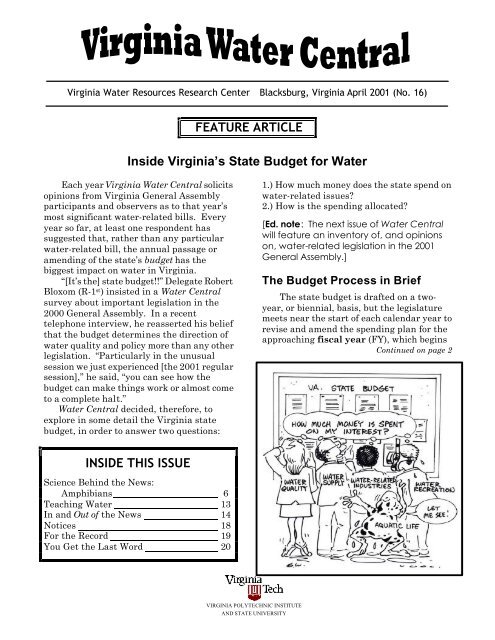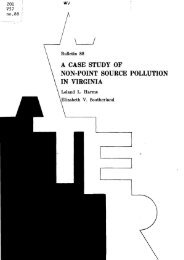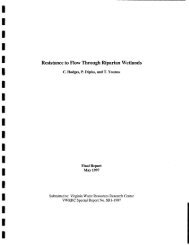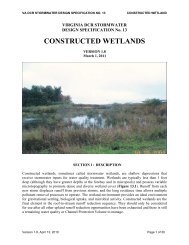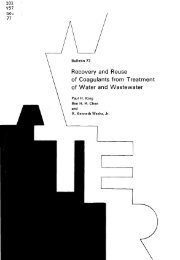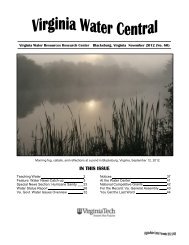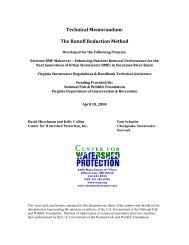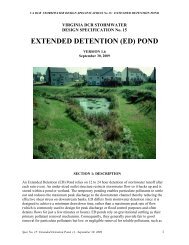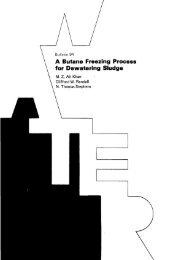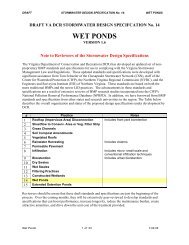FEATURE ARTICLE Inside Virginia's State Budget for Water INSIDE ...
FEATURE ARTICLE Inside Virginia's State Budget for Water INSIDE ...
FEATURE ARTICLE Inside Virginia's State Budget for Water INSIDE ...
Create successful ePaper yourself
Turn your PDF publications into a flip-book with our unique Google optimized e-Paper software.
Virginia <strong>Water</strong> Resources Research Center Blacksburg, Virginia April 2001 (No. 16)<strong>FEATURE</strong> <strong>ARTICLE</strong><strong>Inside</strong> Virginia’s <strong>State</strong> <strong>Budget</strong> <strong>for</strong> <strong>Water</strong>Each year Virginia <strong>Water</strong> Central solicitsopinions from Virginia General Assemblyparticipants and observers as to that year’smost significant water-related bills. Everyyear so far, at least one respondent hassuggested that, rather than any particularwater-related bill, the annual passage oramending of the state’s budget has thebiggest impact on water in Virginia.“[It’s the] state budget!!” Delegate RobertBloxom (R-1 st ) insisted in a <strong>Water</strong> Centralsurvey about important legislation in the2000 General Assembly. In a recenttelephone interview, he reasserted his beliefthat the budget determines the direction ofwater quality and policy more than any otherlegislation. “Particularly in the unusualsession we just experienced [the 2001 regularsession],” he said, “you can see how thebudget can make things work or almost cometo a complete halt.”<strong>Water</strong> Central decided, there<strong>for</strong>e, toexplore in some detail the Virginia statebudget, in order to answer two questions:1.) How much money does the state spend onwater-related issues?2.) How is the spending allocated?[Ed. note: The next issue of <strong>Water</strong> Centralwill feature an inventory of, and opinionson, water-related legislation in the 2001General Assembly.]The <strong>Budget</strong> Process in BriefThe state budget is drafted on a twoyear,or biennial, basis, but the legislaturemeets near the start of each calendar year torevise and amend the spending plan <strong>for</strong> theapproaching fiscal year (FY), which beginsContinued on page 2<strong>INSIDE</strong> THIS ISSUEScience Behind the News:Amphibians 6Teaching <strong>Water</strong> 13In and Out of the News 14Notices 18For the Record 19You Get the Last Word 20VIRGINIA POLYTECHNIC INSTITUTEAND STATE UNIVERSITY
Continued from page 1on the first of each July. Much of thebusiness of any session comes down tostriking compromises that bring into accordthe proposed budgets, or budgetamendments, by both houses of thelegislature and the governor. Ultimately, afinal budget bill is passed and approved bythe governor.In the 2001 General Assembly’s regularsession, however, the governor and thelegislature failed to agree on an amendedbudget <strong>for</strong> FY 2002 (July 1, 2001—June 30,2002). Consequently, the state reverts to thelast approved budget, the one passed in 2000to allocate spending <strong>for</strong> FY’s 2001 and 2002.Partial Analysis of <strong>State</strong> <strong>Water</strong>Spending Done in 1999In 1999, the state Department ofPlanning and <strong>Budget</strong> (DPB) conducted astudy into Virginia’s spending onenvironmental issues <strong>for</strong> Fiscal Year 2000.Their list identified $99.6 million spent thatyear on the following water-related issues:drinking-water quality; fish and wildlifeprotection; marine and coastal management;surface-water quality; and water-resourcemanagement. This amount constituted about0.5 percent of the state’s budget of $21.4billion in that fiscal year.But that wasn’t the complete story onwater-related spending, then or now. Forinstance, the DPB study did not include thestate’s appropriations <strong>for</strong> ports or <strong>for</strong> otherwater-related commerce and transportation,<strong>for</strong> water conservation, or <strong>for</strong> water andmarine research and education. So we soughta more comprehensive picture by examiningthe FY 2002 budget talking to budget expertsin the administration.Start with the Agencies“We have a lot of [state agencies],” saidMarty Farber, senior research associate withthe Division of Legislative Services inRichmond. That’s a bit of anunderstatement; there are nearly a hundredagencies in the executive branch alone. ButMr. Farber nonetheless felt the best way todetermine the state’s spending on waterconcerns would be to consider which of thesemany executive agencies are most likely tohandle water-related issues. He suggestedthe agencies listed in Table 1 (below), a list2Continued on page 3Table 1. Virginia Executive Agencies Most Involved with <strong>Water</strong> Resources.AgencyChesapeake Bay LocalAssistance DepartmentConservation and RecreationEnvironmental QualityForestryGame and Inland FisheriesHealthHousing and CommunityDevelopmentInstitute of Marine ScienceMarine ResourcesCommissionMines, Minerals, and EnergyPort AuthorityMajor <strong>Water</strong>-related ActivitiesAssists localities in the Bay’s watershed in protecting water qualitythrough land-use decisions.Manages state parks and preserves; assists in soil and waterconservation ef<strong>for</strong>ts, dam safety, and resource planning; administersgrants <strong>for</strong> non-point source pollution reduction.En<strong>for</strong>ces federal Clean <strong>Water</strong> Act; oversees waste management issuesand wastewater treatment; administers grants <strong>for</strong> point-source pollutionreduction.Manages use of land and waters within state <strong>for</strong>ests.Regulates fishing, boating, and hunting.Responsible <strong>for</strong> water supply engineering and shellfish sanitation.Provides loans and grants <strong>for</strong> indoor plumbing rehabilitations.Conducts research and education on marine life and habitats.Manages marine fishery and habitat resources.Oversees mine safety, other regulations, and reclamations; responsible<strong>for</strong> protection of groundwater and surface water near mines.Regulates and assists commercial shipping and boating.
Table 2. FY2002 Appropriations <strong>for</strong> <strong>Water</strong>-related Programs in Four Virginia Agencies.4Department of Environmental QualityChemical Emergency Response $75,154Chesapeake Bay Quality and Habitat Monitoring $2,246,924Chesapeake Bay Quality Assessments $4,399,505Coastal Resources Management $1,253,201Construction Assistance $33,562,126Discharge Inspections $3,940,131Discharge Pre-treatment $217,382Discharger Permit Assistance $3,347,169Environmental Education $239,549Environmental Emergency Response $55,479Financial Aid <strong>for</strong> Coastal Resource Management $1,818,853Financial Aid <strong>for</strong> Environmental Resource Management $2,702,479Financial Assistance <strong>for</strong> <strong>Water</strong> Quality $677,163Groundwater Management $633,344Interagency & Intergovernmental Coordination $183,687Interstate Management $136,930Oil Spill Discharge Response $1,744,318Policy and Program Development $248,166Pollution Prevention $902,264Surface <strong>Water</strong> Investigations $622,055Underground Storage Tank Regulation $20,241,213Waste Disposal Site Remediation $1,440,920Wastewater Treatment Plant Operations $177,539<strong>Water</strong> Discharge Permits $3,946,319<strong>Water</strong> Quality Control Construction Assistance $939,345<strong>Water</strong> Quality Planning $873,480<strong>Water</strong> Quality Research $605,323<strong>Water</strong> Resources En<strong>for</strong>cement $1,353,337<strong>Water</strong> Supply Planning $57,754Total $88,641,109Conservation and RecreationAssistance to Soil and <strong>Water</strong> Conservation Districts $4,725,440Dam Safety $362,621Flood Plain Management $642,518Natural Heritage Resources $3,314,027Nutrient Management $223,650Shoreline Management $426,796<strong>State</strong>wide Non-point Pollution Control $8,772,286Urban Non-point Pollution Control $1,085,594Total $19,552,932HealthFinancial Assistance <strong>for</strong> <strong>Water</strong> Supply Monitoring $24,860,000Sewage and Wastewater Regulation $1,957,955Shellfish Sanitation $1,770,229<strong>Water</strong> Supply Engineering $7,832,387Total $36,420,571Housing and Community DevelopmentIndoor Plumbing Assistance $3,030,000Total $3,030,000Four Agencies Total $147,644,612
Continued from page 3The two following subsections explorethese complications.Why Two Agencies Didn’t Make the CutThe DOF appropriation <strong>for</strong> FY 2002 is$24.9 million. DOF devotes some of thatmoney to water-related activities, such aserosion control in state <strong>for</strong>ests and wetlandsprotection, but there are no specific waterrelatedprograms <strong>for</strong> these expenditures. Asexplained by the department’s budgetdirector, Jim Bowen, these ef<strong>for</strong>ts simplymake up a part of the regular duties DOFpersonnel per<strong>for</strong>m in support of the state’s<strong>for</strong>ests, and are given no special distinction inthe agency’s budget. Consequently, Mr.Bowen could not attach a specific percentageof his budget to water-related activities.The situation at DMME is similar. Aspart of its responsibility <strong>for</strong> mine regulationand mine-reclamation en<strong>for</strong>cement, thisagency has a direct role in monitoring andpreventing contamination of surface andgroundwater. But there are no line items <strong>for</strong>this aspect of its duties in the $29-millionappropriation it is to receive in FY 2002.For these reasons, and because waterresources are not the primary focus of thesetwo agencies, we did not include any portionof their budgets in our estimate of waterrelatedspending. Doing otherwise wouldhave involved either guessing about thepercentage of total appropriations theagencies devote to water-related ef<strong>for</strong>ts(something even knowledgeable staffers wereunwilling to do), or categorizing their totalbudgets as water-related. Either approachwould skew the estimate dramatically.And Why Some Programs DidA similar problem exists, though to alesser degree, within some line-itemprograms that clearly involve waterresources. For example, the NaturalHeritage program administers and protectsnature and wildlife preserves. Some of thosepreserves are aquatic and some are not, butthere’s no distinction in the program’s $3million appropriation between aquatic areasand terrestrial areas.At least ten programs within theDepartment of Conservation and Recreationor the Department of Environmental Qualitysimilarly apply state funds to water-relatedactivities while also targeting landconservation, preservation of historic homesand sites, <strong>for</strong>est conservation, and othermeasures. We chose to include the fullappropriations <strong>for</strong> these programs in ourestimate, acknowledging that doing so addeda possible source of overestimation to ourfinal calculation of water-related spending.ConclusionUsing the Virginia’s official budget as aguide, it’s possible to identify $288.9 millionin appropriations in FY 2002 <strong>for</strong> issuesincluding water quality, water conservation,water used <strong>for</strong> recreation, water as a medium<strong>for</strong> transport and commerce, marine andshoreline protection, aquatic-life study andpreservation, and water-related research andeducation. This represents 1.2 percent of thestate’s total appropriations <strong>for</strong> the fiscal year.This estimate does not include all waterrelatedappropriations, because some agencybudgets are not set up to separate waterrelatedexpenditures, and some programswithin agencies similarly devote moneywithout distinction between activities thatare water-related and those that are not.This ef<strong>for</strong>t to identify water-relatedappropriations in the state budget is a firststep toward understanding how the budgetaffects water-related issues in Virginia. Withthis guide <strong>for</strong> tracing a high percentage ofwater-related spending, one could begin toexplore such spending from year to year, aswell as determine how Virginia’s waterrelatedspending compares to that in otherstates. We hope to continue suchexplorations in future issues of <strong>Water</strong>Central.–By David Mudd<strong>Water</strong> Central thanks budget analysts atthe Virginia Department of Planning and<strong>Budget</strong>, Division of Legislative Services, andVirginia Tech <strong>for</strong> their assistance with thisarticle.5
6SCIENCEBEHIND THE NEWSOut of the <strong>Water</strong>,But Not ForeverIn the wordless, beautifully drawnchildren’s book Tuesday 5 , nightfall finds frogsrising from the water on lily pads, leavingbehind astounded fish and turtles as the frogsfly toward town. The frogs chase birds and adog, make capes from sheets hanging out todry, channel-surf as an elderly lady sleeps infront of her television, and in general makemischief all around be<strong>for</strong>e splashing back intothe pond at daybreak. On Main Street onWednesday morning, they leave a trail of lilypads and a befuddled police detectivesearching <strong>for</strong> clues.Sadly, or perhaps thankfully, real-lifefrogs don’t fly on lily pads or by any othermeans. But this book does capture two truthsabout frogs as well as toads and salamanders,the animals known collectively asamphibians. First, amphibians may leavewater at some times, but most have to returneventually, at least to breed. Second, becauseamphibians are especially sensitive toenvironmental conditions around them, theyprovide clues about water quality and otherconditions of the areas they inhabit. In fact,declining amphibian populations and theoccurrence of de<strong>for</strong>med individuals are cluesscientists have been pondering since at leastthe 1970s, with greatly increased attention inthe news since the late 1990s. (For more onthe attention amphibians have been getting,please see “Who’s Talking…” on page 11).When temperatures in Virginia warmduring March and April, the loud and lyricalcalls of Spring Peeper frogs begin. This year,they signaled that it was time <strong>for</strong> <strong>Water</strong>Central to explore tadpoles, toads, bullfrogs,chorus frogs, waterdogs, and the otheranimals that spend part of their lives on landand part in the water—and not just onTuesdays.5 David Wiesner, Tuesday (New York: ClarionBooks, 1991).Amphibian Groups and BiologyAmphibians, having appeared about 350million years ago according to the fossilrecord, were the first vertebrates to evolveinto land-dwelling organisms. Today thereare approximately 4,600 species, classifiedinto three main groups, or orders: frogs andtoads; salamanders; and caecilians (the latterare tropical, limbless, burrowing species; nospecies are found in Virginia). Worldwide,frogs and toads are the largest and mostdiverse amphibian group, with approximately10 times the numbers of frog/toad species assalamander species. In Virginia, though,there are twice as many salamander speciesas frog/toad species (see the following chart).Number of Amphibian SpeciesWorldVirginiaFrogs/Toads approx. 4100 25Salamanders approx. 415 49Caecilians approx. 165 0Total approx. 4600 74Sources: F. H. Pough et al. , Herpetology, 1998;J. C. Mitchell and K. K. Reay, Atlas ofAmphibians and Reptiles in Virginia, 1999.
All amphibians have a moist, smooth,water-permeable skin, and all are “coldblooded”(more correctly referred to asectothermic). Most amphibians have a lifecycle that includes both an aquatic and aterrestrial phase. Beyond these commoncharacteristics, amphibians exhibit greatvariation in their body structure and size,behavior, and ecological relationships. Let’slook in a bit more detail at three key aspectsof amphibian biology.Skin Impact on <strong>Water</strong> and Oxygen<strong>Water</strong> readily passes throughamphibians’ thin, moist skin. In fact,amphibians do not drink water, as theyabsorb it readily from their freshwatersurroundings.On the other hand, amphibians readilylose water through their skin if theirsurroundings are too dry. Some amphibiansare able to tolerate a good deal ofdehydration. For example, the semi-aquaticNorthern Leopard Frog can tolerate a 36-percent body-weight loss of water, and theterrestrial Southern Toad, a 43-percent loss. 6But typically amphibians use behavior toprevent losing too much water. To preservewater, amphibians stay close to water or stayin secluded, humid spots, and they are mostactive at night. Use of burrows is anotherwater-conserving behavior; some amphibiansdig their own, while others occupy those dugby other animals.Staying moist is also necessary <strong>for</strong>amphibians to get adequate oxygen. Much ofamphibian breathing occurs across their skin,which must be kept moist to allow oxygen topass through the skin into the body. As agroup, amphibians can breathe through skin,gills, lungs, and mouth cavity. Some specieshave gills and lungs (both more-or-lessfunctional), while other species have no lungsor gills as adults; the largest family ofsalamanders, <strong>for</strong> example, have no lungs. Inspecies with no lungs or gills, as much as 90percent of gas exchange is through the skin.A Red-spotted Newt, a salamander species foundin most Virginia counties. ©2001 Kenneth J. Stein,Ph.D.; used with permission.Temperature RelationsThe biochemical reactions that sustainliving things require certain temperatures tooccur. While animals (and other livingthings) obviously can tolerate a range oftemperatures, different species do so indifferent ways.As noted above, amphibians, unlike birdsand mammals but like all other animals, areectothermic (also referred to, somewhatmisleadingly, as “cold-blooded)”. This meansthat their body temperature follows closelythe environmental temperature, and thatthey have no (or very little) physiological orchemical way to maintain a constant bodytemperature. Birds and mammals areendothermic, meaning they use energy fromfood to maintain a relatively constant bodytemperature (the actual range depends on thespecies).Rather than using energy from food tomaintain a constant temperature,amphibians and other ectotherms becomeinactive when temperatures are too high ortoo low. This makes ectotherms efficient inusing the energy in their food <strong>for</strong> growth(rather than losing it as heat). For example,a 1980 study indicated that the Red-backedSalamander converts 48 percent of the energyin its food to body mass; the average <strong>for</strong> agroup of 19 species of birds and mammalswas 1.4 percent. 776 R. W. Hill, Comparative Physiology of Animals(New York: Harper & Row, 1976), p. 204.7 F. H. Pough, et al., Herpetology (Upper SaddleRiver, N.J.: Prentice Hall, 1998), p. 15.
The challenges of being an ectothermoccur when temperatures are too hot or toocold. During hot weather, amphibians mustseek out cool and moist areas and becomerelatively inactive (in a dormant state calledaestivation). As temperatures cool below theanimals’ preferred range, amphibians mayremain active but be sluggish; this can makesthem more vulnerable to predators and lessefficient at capturing their own prey. In verycold weather, amphibians seek refuge inareas of high humidity and temperaturesabove freezing, and again become inactive (ina state of hibernation). Depending on thespecies, places of winter refuge include thebottoms of ponds or other water bodies; underlogs, leaves, or other debris on the landsurface; or holes or crevices in the soil belowthe depth of freezing.Life CyclesWithin amphibians as a group,reproductive cycles show great variety, withthree main variations: egg-laying (either inwater or not) followed by developmentinvolving a transitional aquatic larvae; egglaying(either in water or not), followed bydevelopment to adult with no transitionallarval <strong>for</strong>m; and live birth of larvae or tinyadult <strong>for</strong>ms. 8 Overall, the most commonreproductive mode is the one involving a freeliving,aquatic, larval <strong>for</strong>m andmetamorphosis from egg to larva tosubadult to adult (a subadult has the samebody <strong>for</strong>m as an adult but is not yet capableof sexual reproduction).In the typical pattern of amphibianmetamorphosis, the change in body <strong>for</strong>m fromlarva to adult results from many biochemicaland physiological changes throughout theentire larval body. The following chart (nextcolumn) compares certain features generallyseen in amphibian larvae vs. adults.The timing and pattern ofmetamorphosis is inherent in an amphibian’stissues, but the right biochemical conditions8 All three main groups of amphibians include bothegg-laying and live-bearing species, but all NorthAmerican amphibians lay eggs. In many frogspecies worldwide, there is no aquatic larval stage.General amphibianlarvaFully aquaticVegetarianWell-developed gillsLong tailNo eyelidsTeeth and intestinesuited <strong>for</strong> consumingand digesting plantmaterialExcretion ofammonia as primarynitrogen-wasteproduct8General amphibianadultSemi-aquatic orterrestrialCarnivorousWell-developed lungsNo tailEyelidsTeeth and intestinesuited <strong>for</strong> consumingand digesting animalmaterialExcretion of urea asprimary nitrogenwasteproductSource: N. J. Berrill and Gerald Karp,Development, 1976.are needed <strong>for</strong> the development to proceednormally. One key aspect is the hormonethyroxin, specific levels of which are neededat specific times. If thyroxin levels are notcorrect—as can happen, <strong>for</strong> example, if theanimal does not get sufficient iodine—normaldevelopmental processes go astray, andde<strong>for</strong>mities can result in the adultamphibian. Other factors, such as chemicalsand radiation, can alter development as well.Ultraviolet radiation, <strong>for</strong> example, has beenshown experimentally to cause an extra handto <strong>for</strong>m during regeneration of a limb. 9Each amphibian species has its ownpattern of mating. Frog and toad malesgather at breeding time (usually spring) andgenerate “choruses” to attract females; thefemales identify males of their own species bythe calls. Salamanders, however, do not call,so they must use vision and smell to findmates. Fertilization of eggs typically occursoutside of the female’s body (externalfertilization), and fertilized and depositedeggs lack a shell. This makes it necessary <strong>for</strong>amphibians to breed in wet or moist places,as the unprotected eggs would dry out9 Amphibians can regenerate body parts (as canfish, but not reptiles, birds, or mammals).Regeneration of limbs, the tail, the snout, and eveneyes is possible, occurring more readily when theanimal is young or small.
9otherwise; moreover, in species with aquaticlarvae, the eggs must be laid either in wateror where larvae can quickly reach water.Frogs and toads may lay eggs in stillwater, flowing water, tree holes, water-filleddepressions, nests on ground, rocks, leavesover water, the female’s back, or the male’slegs. Salamanders may lay eggs in stillwater, flowing water, nests on the ground, ornests in trees. Some amphibians lay theireggs in clumps, others in strings, and stillothers singly. Many frog and toad species’eggs have colors that help the eggs absorblight and warm faster, speeding development(which depends on temperature). Thenumber of eggs ranges from 1 to 30,000among frog and toad species, butsalamanders lay at most a few hundred eggs.Generally eggs are abandoned, but somesalamanders—Hellbenders, <strong>for</strong> example—guard eggs aggressively. 10 On the otherhand, Hellbenders will also eat some eggs,apparently as an exchange <strong>for</strong> the energyrequired to protect them.Some Aspects of Amphibian EcologyAmphibians as a group are preyed uponby fish, reptiles, birds, and mammals. Someamphibians, too, prey on other amphibians,including members of their own species. 11They are protected somewhat by having aslippery body, by being small andinconspicuous (usually), and by makingvisual displays (such as puffing up theirthroat) or loud sounds to try to intimidatepredators. A noteworthy amphibian defenseis the poisonous skin of some species,poisonous enough to kill or sicken manyanimals as well as humans. (Consequently, itis important to wash your hands afterhandling amphibians. Also, <strong>for</strong> theamphibians’ benefit, moisten your handsbe<strong>for</strong>e handling amphibians, so as10 No Virginia frog species show parental care ofeggs, but frog species in some other parts of theworld do.11 Cannibalism in amphibians typically involvesadults eating larvae or eggs, or larvae eatingsmaller larvae or eggs. It can be widespread whenfood is limited, such as in a temporary pond.A Wood Frog egg mass, with tadpoles preparing toleave the mass. ©2001 Kenneth J. Stein, Ph.D.;used with permission.not to remove any of the animals’ protectivemoisture.)Adult amphibians typically eat insectsand other small invertebrates, although insome species the adults are plant-eaters (andlarvae typically eat plants). This givesamphibians an important role in the flow ofenergy through ecosystems. They can makeuse of small prey that is not as readilyavailable or is not adequate <strong>for</strong> large reptiles,birds, or mammals. As mentioned above(page 7), amphibians are efficient atconverting the food they consume intoamphibian body mass; in doing so, they takeanimals too small <strong>for</strong> larger predators toconsume and “convert them into [amphibiansize]packages that birds and mammals canconsume.” 12Besides their roles in natural systems,amphibians are useful to humans in severalother ways, including the following:•they are consumed as human food;•they have diverse and potent skin toxins ofinterest to pharmacological research;•the relatively large eggs of severalamphibians have been very useful to thestudy of developmental biology; and•salamanders’ “heat-shock proteins”—chemicals that enable them to withstand arapid temperature increase, such as whenthey emerge from shade to a sunny location—have been studied <strong>for</strong> in<strong>for</strong>mation applicableto medicine, including cancer research.12 Pough, et al., Herpetology, 1998, p. 16.
Amphibians in VirginiaWhere would you look to find amphibiansin Virginia? Here are several possibilities: inrivers; along pond and lake margins; infreshwater or brackish wetlands; alongstreams; in temporary pools; in rock creviceson mountains; in caves, tunnels, and mines;and, of course, in your back yard or garden!The two photos to the right show examples ofamphibian habitat in Virginia.Virginia’s diverse geography 13 provideshabitats to support a relatively high numberof amphibian species. Because amphibiansare ectotherms, and because their skin iswater-permeable, an area’s temperature andmoisture greatly influence the suitability ofhabitat <strong>for</strong> amphibians. Average annualtemperature decreases with elevation, soaverage temperature tends to decrease fromeast to west across Virginia. As <strong>for</strong> moisture,the Shenandoah Valley is generally the driestregion (over 33 inches of precipitation peryear), while Lee County is the wettest (over49 inches per year).These factors, combined with ecologicalrelationships with other species (includinghumans), determine where in Virginiaamphibians live (their distribution). Somespecies—<strong>for</strong> example, the AmericanBullfrog—are found in nearly every county inthe state. Other species, such as theAlleghany Mountain Dusky Salamander, arefound in several counties but only in thewestern part of Virginia. Still others arefound in only a very few locations; the ShovelnosedSalamander, <strong>for</strong> example, is knownonly from Mt. Rogers and Whitetop Mountainin southwestern Virginia.Virginia has several rare, endangered, orthreatened amphibian species; the box to theright lists those species. The main threats tothese species are habitat loss (such asthrough development or wetland draining),habitat fragmentation (such as dividing areasby roadways); and habitat modification bypollution, excessive sediments, etc.Continued after box on page 1113 Virginia has five distinct geographic areas:Coastal Plain, Piedmont, Blue Ridge, Valley andRidge area, and Cumberland Plateau.Amphibian habitat at Pandapas Pond,Montgomery County, Va.Rare, Endangered, and ThreatenedAmphibians in VirginiaOn federal endangered species listShenandoah SalamanderOn federal threatened species listMabee’s SalamanderOn Virginia endangered species listEastern Tiger SalamanderOn Virginia threatened species listBarking TreefrogOf “special concern”* in VirginiaOak ToadCow Knob (or White-spotted) SalamanderHellbender (a salamander)Mole SalamanderPeaks of Otter SalamanderPigmy SalamanderShovel-nosed SalamanderWeller’s Salamander*“Special Concern” in not a legal category, as“threatened” and “endangered” are.Source: Virginia Department ofConservation and Recreation/Division ofNatural Heritage Web-site, March 23, 2001.10
Who’s Talking about Amphibians1998•“[S]choolchildren discovered grossly de<strong>for</strong>med frogs in [a Minnesota pond in the summer of 1995…. Frogswith [de<strong>for</strong>mities] have been found throughout Minnesota,…Vermont, Oregon, and Delaware…Suchde<strong>for</strong>mities have been under study in Quebec…by the Canadian Wildlife Service since 1992.”— WilliamSouder, “A Possible Leap Forward on Amphibian Abnormalities,” Washington Post, March 16, 1998, p. A3.11•“Herpetologists with 30 years of field experience are reporting that many frogs and toads are simplydisappearing from large parts of their <strong>for</strong>mer range.” In response, the Declining Amphibian PopulationsTask Force (DAPTF) was <strong>for</strong>med in 1991. It now has over 3000 members in 90 countries.—Julie Griffin,“Amphibian Decline: Monitors Search <strong>for</strong> Answers,” Volunteer Monitor, Vol. 10, No. 1 (Spring 1998).•The Michigan Department of Natural Resources started conducting an annual frog and toad survey in1996. “Frogs and toads are our watchdogs,” said a volunteer monitor. “[Frogs are] a pretty goodenvironmental indicator. They’re sort of a biological sponge,” said Michigan <strong>State</strong> University herpetologistJames Harding.—Malcolm Johnson, “Frog Survey Gives Pollution Clues,” Associated Press, May 17, 1998.1999•“Increased public awareness of declining populations, habitat loss, environmental pollution, and passage ofthe federal Endangered Species Act and the Virginia Endangered Species Act have focused attention on thestate’s native species [of amphibians and reptiles].”—Joseph Mitchell and Karen Reay, Atlas of Amphibiansand Reptiles in Virginia, 1999.2000•An analysis of 936 amphibian populations worldwide showed “relatively rapid declines [globally] from thelate 1950s/early 1960s to the late 1960s, followed by a reduced rate of decline [but still dropping] to thepresent.” In North American, populations declined during the 1960s and from the 1970s to the late 1990s.Out of all the populations , 56.6 percent were declining.—Jeff E. Houlahan et al., “Quantitative Evidence <strong>for</strong>Global Amphibian Population Declines,” Nature, Vol. 404 (April 13, 2000), pp. 752-755.•The U. S. Fish and Wildlife Service began a study in 2000 of frog-de<strong>for</strong>mity rates at 43 national wildliferefuges in 31 states. They introduced the project at the Patuxent Research Refuge in Laurel, Md., whereponds sampled in 1999 had “higher than normal rates of de<strong>for</strong>med frogs” (it was 5 percent). “It’s probablynormal to have about one or two percent of frogs de<strong>for</strong>med…[but some refuges] have had rates as high as 17percent.”—Fern Shen, “Why is This Frog Worried?” Washington Post, Aug. 8, 2000, “KidsPost” section.Continued from page 10Unlike with some other groups ofanimals or with plants, there are not manyestablished populations of non-nativeamphibians in Virginia. Individuals of somespecies (the Cuban Treefrog, <strong>for</strong> example) aresometimes imported on horticultural plants,but they usually can’t survive here. It isillegal to release such animals into the wild.ConclusionWhit Gibbons and James Sweeney,writing in a recent issue of the NationalWetlands Newsletter, 14 note several reasons14 “Partnering <strong>for</strong> Herpetofauna Conservation—thePARC Approach,” National Wetlands Newsletter,Sept.-Oct. 2000, p. 3.why people “care about amphibians.” Thefollowing three reasons stand out asespecially compelling and well-put:•Amphibians are “beautiful, mysterious,fascinating animals prominent in the history,religion, and mythology of many cultures….”•They are “inhabitants of wetlands andterrestrial habitats with diverse and complexroles in nutrient cycling, seed dispersal, andas predator and prey” [including as predatorson mosquitoes and other pests to humans].•They are “heralds of environmentalhealth….”Amphibians live, usuallyinconspicuously, all around us, as well as inplaces where most people will never go andcould not survive—deserts on the one hand,northern Alaska on the other. Their
inconspicuous habits have helped themsurvive <strong>for</strong> millions of years, but theircomplex life cycles—involving both land andwater habitats—make them vulnerable to anumber of modern-day threats. News reportsover the past few years show a growingawareness of these diverse and interestinganimals and their status. But to enhanceyour own awareness, put aside the news, goto a wet area, and listen <strong>for</strong> a frog “chorus.”—By Alan Raflo<strong>Water</strong> Central thanks Carola Haas,Virginia Tech Department of Fisheries andWildlife Science, <strong>for</strong> her assistance with thisarticle; and Kenneth Stein, ConservationManagement Institute at Virginia Tech, <strong>for</strong>permission to use his photographs.Definitions <strong>for</strong> Words in Bold•Distribution—when applied to a biology, thisrefers to the pattern of occurrence of the speciesor population. The geographic area in whichthe species or population is distributed isknown as the range.•Ectotherm/endotherm—terms synonymouswith the more common but misleading terms“cold-blooded” and “warm-blooded,”respectively. Ectotherms depend on theexternal environment to provide body heat;their body temperature fluctuates with externalconditions. Endotherms generate body heatfrom their food and maintain a relativelyconstant body temperature.•Herpetologist—one who studies amphibiansand reptiles, from a Greek word verb meaning“to creep.” Amphibians and reptiles collectivelyare often referred to as “herps.”•Metamorphosis—a dramatic but predictablechange in body <strong>for</strong>m and habits as an animalprogresses from an egg to adult.•Population—the individuals of a certainspecies within a particular area. For example,one can refer to the population of AmericanToads in a single backyard garden, in a givenVirginia county, in all of Virginia, and so <strong>for</strong>th.•Vertebrate—a member of the group ofanimals that have a backbone; this groupincludes fishes, amphibians, reptiles, birds, andmammals.Scientific Names of AmphibiansMentioned(* indicates not found in the wild in Virginia)FrogsAmerican Bullfrog—Rana catesbeianaBarking Treefrog—Hyla gratiosa*Cuban Treefrog—Osteopilu septentrionalis*Northern Leopard Frog—Rana pipiensSpring Peeper—Pseudacris cruciferWood Frog—Rana sylvaticaToadsAmerican Toad—Bufo americanusOak Toad—Bufo quercicusSouthern Toad—Bufo terrestrisSalamandersAlleghany Mountain Dusky Salamander—Desmognathus ochrophaeusCow Knob Salamander—Plethodon punctatusEastern Tiger salamander—Ambystomatigrinum tigrinumHellbender—Cryptobranchus alleganiensisMabee’s Salamander—Ambystoma mabeeiMole Salamander—Ambystoma talpoideumPeaks of Otter Salamander—PlethodonhubrichtiPigmy Salamander—Desmognathus wrightiRed-backed Salamander—Plethodon cinereusRed-spotted Newt—Notophthalmus viridescensviridescensShenandoah Salamander—PlethodonshenandoahShovel-nosed Salamander—DesmognathusmarmoratusSpotted Salamander—Ambystoma maculatumWeller's Salamander—Plethodon welleriHmmm…I wonder ifany of thosereporters knowhow “Hellbenders”got their name?12
References UsedOn Amphibians in GeneralBerrill, N. J. and Gerald Karp. Development.New York: McGraw-Hill, 1976.Buck, Margaret W. Where They Go in Winter.Nashville: Abingdon Press, 1968.Hill, Richard W. Comparative Physiology ofAnimals. New York: Harper and Row, 1976.Pough, F. Harvey, R. M. Andrews, J. E.Cadle, Ma. L. Crump, A. H. Savitzky, and K. D.Wells. Herpetology. Upper Saddle River, N.J.:Prentice Hall, 1998.Smith, Hobart M. A Guide to FieldIdentification of Amphibians of North America.Racine, Wisc.: Western Publishing Co., 1978.Zim, Herbert S. and Hobart M. Smith.(Golden Guide to) Reptiles and Amphibians. NewYork: Golden Books, 1987.On Amphibians in VirginiaMartof, Bernard S., W. M. Palmer, J. R.Bailey, and J. R. Harrison. Amphibians andReptiles of the Carolinas and Virginia. ChapelHill: Univ. of North Carolina Press, 1980.Mitchell, Joseph C. “Amphibians andReptiles.” Pages 411—476 in Virginia’sEndangered Species, Karen Terwilliger, ed.Richmond: Va. Dept. of Game and InlandFisheries, 1991. Distributor: McDonald andWoodward, Granville, Ohio, (800) 233-8787.Mitchell, Joseph C. and Karen K. Reay. Atlasof Amphibians and Reptiles in Virginia.Richmond: Va. Dept. of Game and InlandFisheries, 1999.For More In<strong>for</strong>mationU. S. Geological Survey•The USGS runs the North American ReportingCenter <strong>for</strong> Amphibian Mal<strong>for</strong>mations. (800) 238-9801; www.npwrc.usgs.gov/narcam/index.htm.•Frogwatch USA is an educational, long-term frogand toad monitoring program. Frogwatch USACoordinator; Patuxent Wildlife Research Center,USGS—Biological Resources Div., 12100 BeechForest Road; Laurel, MD 20708-4038; (301) 497-5819; e-mail: frogwatch@usgs.gov; www.mp2-pwrc.usgs.gov/frogwatch/index.htm.Virginia Herpetological Society.This group pursues education, research, andconservation related to amphibians and reptiles.VHS Secretary/Treasurer, Dept. of Biology,Liberty Univ., 1971 Univ. Blvd., Lynchburg, VA24502; e-mail: vhsociety@mindspring.com;vhsociety.home.mindspring.com.Va. Dept. of Game and Inland FisheriesThe regulatory agency <strong>for</strong> amphibians inVirginia. Game regulations applicable toamphibians are summarized in Mitchell andReay, pp. 23-24 (reference listed above). Theregulations themselves are available on-line atwww.dgif.state.va.us/fishing/regs/section7.html.Related Museum Exhibit“Shake, Slither, and Swim” is a Va.Museum of Natural History exhibit on reptilesand amphibians. The exhibit runs from April27—October 7 in Martinsville. For morein<strong>for</strong>mation, phone (540) 666-8800;www.vmnh.org.13TEACHING WATEREspecially <strong>for</strong> Virginia’s K-12 teachersThis Issue and the Virginia Standards of LearningBelow are suggested Virginia Standards of Learning (SOLs) supported by this issue’sFeature, Science, and For the Record sections. Abbreviations: BIO=biology; C/T=computertechnology; ES=earth science; LS=life science.Feature Article—<strong>Water</strong> in the <strong>State</strong> <strong>Budget</strong>Science SOLs: 6.11, ES.7.Social Studies SOLs: 7.4, 12.8.Science SOLs: 1.5, 2.4, 3.4, 3.6, 3.10, 4.5, 4.8, 5.5,6.9, LS.5, LS.7, LS.8, LS.9, LS.11, LS.12,BIO.5, BIO.7, BIO.8, BIO.9.Science Article—Amphibians
For the Record:Groundwater In<strong>for</strong>mation SourcesComputer Technology SOLs: C/T5.3, C/T8.4.Science SOLs: 4.8, 6.11, ES.7, ES.9.Social Studies SOLs: 10.9, 11.15.14
15IN AND OUT OF THE NEWSNewsworthy Items You May Have MissedThe following summaries are based on in<strong>for</strong>mation in the source(s) indicated at theend of each item. Selection of this issue's items ended April 3, 2001. Unless otherwisenoted, all localities mentioned are in Virginia.In Virginia…•The Hampton Roads Sanitation District(HRSD) and BP-Amoco kicked off a newwater-conservation ef<strong>for</strong>t last December.Under their agreement, HRSD pumps 500,000gallons/day of “reclaimed wastewater” from theYork River Wastewater Treatment Plant to the oilcompany’s Yorktown refinery, to be used ascoolant. This ef<strong>for</strong>t is a first in Virginia. It willreduce the amount of wastewater HRSDdischarges to the York River, and BP-Amoco willpay less <strong>for</strong> the wastewater than they would <strong>for</strong>an equal amount of drinking-quality water.In another water-conservation ef<strong>for</strong>t in thatarea of the state, the James City ServiceAuthority (JCSA) is launching an ef<strong>for</strong>t to reducesummer peak demands <strong>for</strong> water. JCSA is thelargest water system in the state solely dependenton groundwater. It hopes to reduce summerdemand spikes—which are sometimes 50 percenthigher than average daily usage rates—with a<strong>Water</strong> Conservation Education and In<strong>for</strong>mationCampaign, Irrigation Association certificationprograms <strong>for</strong> landscape professionals, waterconservinglandscaping demonstrations at theJSCA office grounds, and water-managementtraining workshops <strong>for</strong> commercial and multiresidentialusers. (Update, Regional Raw <strong>Water</strong>Study Group, Winter 2000/2001)•The Kim-Stan Landfill in Alleghany County,closed in 1990, is not a hazard to humans inthe area, according to a draft report by the federalAgency <strong>for</strong> Toxic Substances and DiseaseRegistry. The agency, which is part of the U. S.Department of Health and Human Services,detected chemicals in surface water, soil, andsediment but not in concentrations consideredthreatening to humans. It also foundcontamination in groundwater beneath thelandfill, but the water is not used <strong>for</strong> drinking orother domestic purposes, so it too was ruled out asa hazard. The report, which is available at theClifton Forge Public Library and the LancasterCommunity College Library, recommends moresampling of water, soil, and gaseous emissions atthe site. The U. S. Environmental ProtectionAgency (EPA) is to release more data later thisyear on contaminants at the site, which wasplaced on the National Priorities List ofSuperfund sites in 1999. (Roanoke Times, 1/9/01)•About 41 percent of state-monitored riversand streams are impaired—that is, fail to meetone or more state water-quality standards—theVirginia Department of Environmental Quality(DEQ) reported early in the year. That comparesto an almost equal percentage of impairedstreams and rivers across the nation, and is feltby DEQ to be a more accurate representation thanreported in years past. (Richmond Times-Dispatch, 1/22/01)Meanwhile, the DEQ has prepared a costestimate <strong>for</strong> cleaning impaired rivers andstreams in the state. In a report submitted tothe Virginia General Assembly in February, theagency estimated that over the next decade it willcost about $60 million <strong>for</strong> planning, and $300 <strong>for</strong>implementation, <strong>for</strong> 648 plans (Total MaximumDaily Loads, or TMDLs) to clean up some 600impaired stream segments (stretching nearly 4000miles). (Richmond Times-Dispatch, 2/8/01)•The town council of Tangier Island (pop.approximately 700) has reached agreement withthe DEQ on a set of pollution-controlmeasures. The measures are intended to solveseveral long-standing problems: the island’swastewater treatment plant has been pumpingpoorly-treated water into the Chesapeake Bay; itsincinerator doesn’t meet clean air standards; andresidents have been dumping large trash items inthe island’s marshes. Tangier has agreed to beginremedying these problems by increasing utilityfees on residents and by turning management ofits sewer and incinerator systems to a privatefirm, Maryland Environmental Services, Inc. Thestate is to help fund the changes with a grant of$125,000 from the Virginia EnvironmentalEmergency Response Fund. The Virginia <strong>Water</strong>Control Board, and perhaps other agencies, mustfirst approve the agreement. (Richmond Times-Dispatch, 1/26/01)
•On January 24, the Maryland Department ofEnvironment (MDE) issued a permit <strong>for</strong>Fairfax County to extend a water-intakepipe farther into the Potomac River. MDE tookthe action, however, only because of a court order,and Maryland officials plan to appeal that order.Fairfax officials have said they wanted theextension only because water taken from deeperin the river is cleaner, but Maryland GovernorParris Glendening and other state officials havesuggested the fast-growing Virginia county wantsmore water to serve development. (RichmondTimes-Dispatch, 1/26/01)•The number of registered boats and otherwatercraft in Virginia is rising while thenumber of boat-related accidents andfatalities is dropping. There were 240,317registered boats in the state in 2000, with 179reported accidents resulting in 17 deaths. In1999, with nearly 2000 fewer boats registered, 200accidents were reported, with 21 deaths. Themost significant decrease in accidents andfatalities has been in the personal-watercraftcategory, with 40 reported accidents last yearcompared to 90 in 1997. (Roanoke Times, 2/16/01)•Considering a case against Smithfield Foodsby the state <strong>Water</strong> Control Board, the VirginiaSupreme Court ruled in March that Virginiacannot recover penalties from Clean <strong>Water</strong> Actviolators when the U. S. EPA has already finedthe same violator <strong>for</strong> the same infraction. Theruling is expected to have national implications,because it is apparently the first time a statecourt has made such a ruling. (<strong>Inside</strong> EPA <strong>Water</strong>Policy Report, 3/12/01)•In an ef<strong>for</strong>t to rebuild the state’s depletedoyster population, the Virginia MarineResources Commission (VMRC) has asked the U.S. Army Corps of Engineers <strong>for</strong> permission todredge millions of bushels of ancient oyster shellsfrom beds in the Elizabeth and James rivers. Theold shells will be used to construct reefs <strong>for</strong>seeding young oysters into the Rappahannock,Elizabeth, and Bank rivers, as well as Tangierand Pocomoke sounds. The VMRC wants torelocate as many as 35 million bushels of theshells over the next five years. The oyster beds tobe dredged support very few living oysters: insome areas, disease-causing organisms arepresent; in other areas, encroachment of freshwater makes the areas inhospitable to oysters.(Richmond Times-Dispatch, 3/14/01)…and Outside of Virginia•An October report by the World ResourcesInstitute stated that “four out of every 10people [around the world] live in riverbasins that are experiencing water scarcity.”In addition, the report claims that many of theworld’s freshwater systems are seriously degradedin their capacity to support human, animal, andplant life. The report, “Pilot Analysis of GlobalEcosystems: Freshwater Systems,” can be viewedon-line at www.wri.org/wri/wr2000 (click on“Freshwater Systems”). (National WetlandsNewsletter, Nov.-Dec. 2000)•In January, the U. S. Supreme Court ruled thatthe Clean <strong>Water</strong> Act does not give the EPAor the Army Corps of Engineers authorityover all bodies of water in the United <strong>State</strong>s.As a result of a lawsuit against the Corps by theSolid Waste Agency of Northern Cook County (inthe Chicago area), the court ruled the Corps’jurisdiction over “navigable waters” does notapply to isolated waters (including wetlands) thatare not navigable. In the case, the wasteauthority sought to develop a landfill site whereseveral drainage sites had essentially evolved intowetland habitat <strong>for</strong> migratory birds; areaenvironmentalists had sought to protect thehabitat. (<strong>Inside</strong> EPA Weekly Report, 1/10/01)•On January 12, the U. S. Food and DrugAdministration (FDA) and the EPA jointly issuedadvisories on mercury in commerciallyavailable as well as non-commercial fish.The FDA recommended that pregnant or nursingwomen and young children not eat shark,swordfish, king mackerel, or tilefish, and thatthey eat no more than an average of 12 ounces ofother fish per week. The EPA recommends thatpregnant or nursing women limit to six ounces(cooked fish) per week their consumption offreshwater fish caught by subsistence orrecreational fishers; young children shouldconsume no more than two ounces per week. Formore in<strong>for</strong>mation about mercury in seafood, phonethe FDA toll-free at (888) 723-3366; or visit theirWeb-site at www.cfsan.fda.gov. In<strong>for</strong>mation onthe EPA advisory is available on-line atwww.epa.gov/ost/fish. (Sources <strong>for</strong> this item arethe two Web-sites mentioned, April 2001)In a related story close to Virginia, stateofficials say mercury is the leading cause offish advisories in North Carolina. In fact, thestate was the first on the East Coast to issue awarning about eating too much king mackerel.(Raleigh News-Observer, 1/22/01)16
•The American <strong>Water</strong> Works AssociationResearch Foundation announced in Januarythe awarding of 48 project grants <strong>for</strong> 2001.Nearly $11 million was given to projects in sixdisciplines: reducing microbial risk in drinkingwater; protecting consumers from chemicals indrinking water; improving water quality andwater-system management <strong>for</strong> utilities; improvingwater-delivery infrastructure; in<strong>for</strong>mingconsumers about the science and technology ofdrinking-water supply and protection; andensuring access to and wise use of waterresources. (AWWA Mainstream, February 2001)Another sample of what’s happening in waterresearch comes from a recent list of projectssupported by the National Research Council’s<strong>Water</strong> Science and Technology Board. Someof the topics being addressed are these: thescientific basis <strong>for</strong> the Total Maximum Daily Load(TMDL) approach to water-pollution reduction;toxins and pathogens in biosolid fertilizers;restoration of the Everglades; drinking-watercontaminants; environmental remediation at U. S.Navy facilities; the Missouri River ecosystem;privatization of water services; functions ofriparian zones; and mitigating wetland losses.(WSTB Newsletter, Jan.-Feb. 2001)•It’s known that North Carolina is home to morethan 770 closed landfills. What’s not known iswhat condition many of those landfills arein, nor exactly where many of them are. It alsoisn’t known how many may be contributing togroundwater contamination, though officialssuspect it’s a high percentage because manyoperated be<strong>for</strong>e requirements (<strong>for</strong> liners and othermeasures) were in place to prevent contamination.The state has begun an ef<strong>for</strong>t to catalogue thesites and eliminate contamination hazards ifpossible. Landfills are “officially blamed” <strong>for</strong> 58groundwater-contamination incidents, but thatnumber underestimates the problem, according tothe state’s groundwater section chief. (CharlotteObserver, 2/5/01)•Many observers expect the new Congress toallow appropriations <strong>for</strong> major waterinfrastructure initiatives this year. Twoinfluential interest groups disagree about thepotential billions of new spending. The <strong>Water</strong>Infrastructure Network (WIN), made up of localgovernment groups, water-treatment and watersupplyinterests, and environmentalists, hasrecommended that Congress authorize $57 billion<strong>for</strong> infrastructure spending over five years. Onthe other hand, the H20 Coalition, consisting ofthe National Association of <strong>Water</strong> Companies,water- and wastewater-equipment producers, andthe National Council <strong>for</strong> Public/PrivatePartnerships, agrees that much of the country’swater infrastructure has problems but says theprice is too much <strong>for</strong> the government to pay on itsown. It has recommended alternative sources offunding. (<strong>Inside</strong> EPA <strong>Water</strong> Policy Report,2/12/01)17•A recommendation has been made by researchersat East Carolina University that a bi-state panelbe <strong>for</strong>med to manage the Waccamaw Riverbasin in North Carolina and South Carolina.The researchers’ report, still under review by theNorth Carolina Division of <strong>Water</strong> Resources,concludes that the area is under increasingpressure from development that is taxing thewater table, and that logging activity in the GreenSwamp—a vital contributor to the river’s flow—isdraining the shallow parts of the swamp andfilling the deeper parts with sediment.(Wilmington Star, 2/25/01)•A recent study by the University of NorthCarolina suggested it may be more important toen<strong>for</strong>ce more fully existing laws regulatingerosion and run-off controls at constructionsites than to pass more restrictive rulings.Researchers found that water-quality degradationwas “significantly impacted by en<strong>for</strong>cementactivities” at construction sites along testedstreams in the state, while at sites whererestrictions were stronger but en<strong>for</strong>cement waslax, water quality suffered. This finding suggestsimplementation of EPA’s “Phase II” stormwaterregulations of small construction sites and sewersystems, set <strong>for</strong> next year, may have limitedimpact because en<strong>for</strong>cement personnel nationwideare already stretched. (<strong>Inside</strong> EPA <strong>Water</strong> PolicyReport, 2/26/01) [Ed. note: For more onstormwater issues, please see the Feature Articlein the February 2000 <strong>Water</strong> Central.]•The Army Corps of Engineers chose tosuspend a $60-million study of potentialconstruction projects on the MississippiRiver after an independent review by theNational Academy of Sciences (NAS) concludedthere were serious problems with projections andmethods in the study. The report praised theCorps <strong>for</strong> improving its economic models, but itcriticized it <strong>for</strong> overestimating barge traffic on theMississippi, using inaccurate assumptions, payingtoo little attention to environmental concerns, andignoring non-structural methods (such asscheduling changes) to relieve barge congestion.(Washington Post, 3/1/01)
•The Chesapeake Bay gets most of the attention,but Maryland is also concerned about its otherbays. The state Department of Natural Resourceshas announced plans <strong>for</strong> a survey this summerto determine the health of Chincoteague,Sinepuxent, Isle of Wight, and Assawomanbays. Officials say they are concerned aboutencroaching development and heavy agriculturaluse in areas adjacent to the bays, and they wantto get a sense of water quality and marine life ineach bay as a first step in developing plans tostabilize their health. (Baltimore Sun, 3/15/01)•In a November 2000 report, the North CarolinaMarine Resources Commission (NCMRC) assertedthat if all proposed ef<strong>for</strong>ts to replenish thestate’s beaches were implemented, theywould pose a “real and significant threat” tocoastline and marine resources. Pumpingsand to rebuild small stretches of beach has beena regular practice <strong>for</strong> decades, but there areserious plans now <strong>for</strong> large-scale rebuilding ofshorelines along nearly 120 miles of the state’s300-mile coast. This beach rebuilding would bothreduce threats of shoreline erosion to existingbeachfront developments and pave the way <strong>for</strong>additional development. But it worries somebiologists and fish and wildlife officials whobelieve many marine animals living along thestate’s shores depend on conditions found onnarrow beaches—conditions that are altered oreliminated by beach replenishment. They contentthat marine life is also further affected by alteredcircumstances at sites where sand is dredged <strong>for</strong>transport to shorelines. The NCMRC is urgingstate officials to review all proposed projects.(Winston-Salem Journal, 3/15/01)•Just when you may have gotten accustomed toTMDLs, along comes another somewhatneglected aspect of the national Clean <strong>Water</strong>Act (CWA): antidegredation. The CWArequires that state water-quality programs havethree main elements: designated uses <strong>for</strong> waterbodies; numerical measurements <strong>for</strong> regulatingpollutant discharges; and an anti-degradationpolicy to protect existing water quality and uses.But over 20 states have no antidegradation policyin place, and the U. S. EPA is concerned thatthere may be increased litigation regarding thispolicy, similar to the many lawsuits over TMDLsin recent years.West Virginia is one arena whereantidegradation is currently being debated. Thestate’s Division of Environmental Protection hasproposed one antidegradation plan; a consortiumof industries has proposed another. Someenvironmental activists, such as the West VirginiaRivers Coalition, contend that neither plan maydo enough to protect water quality, and the RiversCoalition may sue the EPA if the West Virginialegislation passes a policy that the groupconsiders too lenient. (<strong>Inside</strong> EPA <strong>Water</strong> PolicyReport, 3/26/0118•As has been widely reported, the EPA wasordered by the Bush Administration to suspendimplementation of a stricter standard <strong>for</strong>arsenic in drinking water. The stricterstandard of 10 parts per billion (ppb) was toreplace the current 50-ppb level, which was set inthe 1940s. The final regulation, having beenthrough a contentious review process over severalyears, was published in the Federal Register onJanuary 22, 2001. The White House delayed therule’s implementation <strong>for</strong> an initial 60 days(through March 22). On March 20, EPA DirectorChristine Todd Whitman delayed itsimplementation <strong>for</strong> an additional 60 days. Duringthis period, the agency is expected to begin the<strong>for</strong>mal process of withdrawing the regulation <strong>for</strong>further review. The 50-ppb standard likely wouldremain in place during such a review.(Washington Post, 3/21/01; and <strong>Inside</strong> EPA <strong>Water</strong>Policy Report, 3/26/01)—By David MuddCORRECTION FROM THE PREVIOUSISSUE OF WATER CENTRALThe Feature Article cartoon (page 1) in theJanuary 2001 issue had the words “Disinfection”and “Infiltration” reversed. The correct cartoon isprinted here:
19N O T I C E SOn the Public Calendar•May 24—Virginia Pollution Prevention AdvisoryCommittee. DEQ Piedmont Regional Office,Richmond, 10 a.m. For more in<strong>for</strong>mation contactSharon Baxter, e-mail: skbaxter@deq.state.va.us; orby phone at the DEQ central office in Richmondtoll-free in Virginia, (800) 592-5482.•June 6—<strong>State</strong> <strong>Water</strong> Control Board. GeneralAssembly Building, Richmond, 9 a.m. For morein<strong>for</strong>mation contact Cindy Berndt, e-mail:cmberndt@deq.state.va.us; or by phone at the DEQcentral office (see number above).Directory of River/<strong>Water</strong>shed GroupsRiver Network offers a CD-ROM with asearchable database of over 3,500 river andwatershed conservation groups in the United<strong>State</strong>s. The directory is also available atwww.rivernetwork.org. For more in<strong>for</strong>mation,contact River Network at 520 SW Sixth Ave., Ste.1130, Portland, OR 97204-1535; (503) 241-3506; e-mail: info@rivernetwork.org.Canoe Through Rivers and HistoryThe Mattaponi and Pamunkey RiversAssociation is selling a canoe-trail guide <strong>for</strong> thesetwo tributaries to the York River. The guide,consisting of five maps on waterproof paper,covers history, recreation, natural features, andtidal in<strong>for</strong>mation. For more in<strong>for</strong>mation, or topurchase the maps, contact MPRA, P. O. Box 242,Manquin, VA 23106; (804) 769-0841.Upcoming Conferences•Seventh National <strong>Water</strong>shed Conference,sponsored by the National <strong>Water</strong>shed Coalition,May 20—23, Richmond. For more in<strong>for</strong>mation,contact John Peterson, (703) 455-6886; e-mail:jwpeterson@erols.com.•Lake and Pond Management Workshop,sponsored by Virginia Cooperative Extension(VCE), May 30, Virginia Beach. For morein<strong>for</strong>mation, contact the VCE in Virginia Beach,(703) 427-4769.•Forest Road Stream Crossings, sponsored bythe Virginia Tech Dept. of Forestry, June 1,Blacksburg. For more in<strong>for</strong>mation, contactMichael Aust, (540) 231-4523; e-mail:waust@vt.edu; Web-site:www.conted.vt.edu/strmxing.htm.At the <strong>Water</strong> CenterFor more in<strong>for</strong>mation about any item below,call the <strong>Water</strong> Center at (540) 231-5624; e-mail:water@vt.edu; or visit www.vwrrc.vt.edu•New Video <strong>for</strong> Loan: Lake SamplingTechniques, produced by Massachusetts <strong>Water</strong>Watch Partnership, 1998; 15 minutes. Showsprocedures <strong>for</strong> sampling lake depth, temperature,Secchi depth, nutrients, and chlorophyll, andshows chlorophyll-filtering process. The datacollection <strong>for</strong>ms shown are specific toMassachusetts, but the sampling techniques areapplicable elsewhere.•Research in Progress: Len Shabman isserving as an adviser to a congressionallymandated study of the science behind the TotalMaximum Daily Load (TMDL) process. Acommittee appointed by the <strong>Water</strong> Science andTechnology Board of the National Academy ofSciences (NAS) is conducting the study. Thereport will be issued by June 2001.•Research Paper: “The Role of <strong>Water</strong> ResourcesInstitutes in In<strong>for</strong>mation Dissemination: TheVirginia <strong>Water</strong> In<strong>for</strong>mation and TechnologyTransfer Web Site,” by Jane Walker and TamimYounos. Presented at the Third <strong>Water</strong>In<strong>for</strong>mation Summit in Miami, Nov. 2000. Thepaper is available on-line atwww.waterweb.org/wis3/pub-paper.ihtml.•Research Paper: “A Service-Learning Programand its Role in <strong>Water</strong>shed Management,” by Janewalker, Tamim Younos, and Alan Raflo.In Integrating Universities' Knowledge andStudent Service-Learning into Community-Based<strong>Water</strong>shed Management Programs, C. Lewicki andT. Younos, eds., <strong>Water</strong> Resources Update No. 119,Universities Council on <strong>Water</strong> Resources, 2001.Article reprints are available from the <strong>Water</strong>Center; the entire booklet is available from theUniversities Council, e-mail: ucowr@siu.edu.•Grant Received: “Capacity Development andRestructuring of Small <strong>Water</strong> Systems.” Thegoals of this study are to develop the concept ofcooperative <strong>for</strong> the technical and fiscalmanagement of small drinking-water systems,and to demonstrate the concept in a Virginialocality. Funded through the Va. Dept. of Health.For more in<strong>for</strong>mation, contact Tamim Younos at(540) 231-8039; e-mail: tyounos@vt.edu.
20FOR THE RECORDSources <strong>for</strong> Selected <strong>Water</strong> Resources TopicsGroundwater In<strong>for</strong>mation Sources(Please see the February 1999 issue of<strong>Water</strong> Central, p. 15, <strong>for</strong> a previous articleidentifying sources of groundwaterin<strong>for</strong>mation.)Virginia Ground <strong>Water</strong> ProtectionSteering Committee (GWPSC)The GWPSC is a good starting point <strong>for</strong>general in<strong>for</strong>mation or <strong>for</strong> sources of more specificdata. The staff contact person is Mary AnnMassie, Va. Department of EnvironmentalQuality, (804) 698-4042; e-mail:mamassie@deq.state.va.us; Web-site:www.deq.state.va.us/gwpsc/home.html.The GWPSC’s 2000 Annual Report includesin<strong>for</strong>mation on Virginia’s Aquifer SusceptibilityStudy, a Virginia Beach groundwater assessment,and on other topics.U. S. Geological Survey (USGS)The USGS gathers and makes publiclyavailable a great deal of water-relatedin<strong>for</strong>mation, including groundwater in<strong>for</strong>mation.The headquarters and Eastern Regionaloffice are located USGS National Center, 12201Sunrise Valley Drive, Reston, VA 20192; (703)648-4000; Web-site: www.usgs.gov. The USGS’Virginia District Office is located at 1730 EastParham Road, Richmond, 23228; (804) 261-2600;e-mail: dc_va@usgs.gov;Web-site: water.usgs.gov/wid/html/va.html.The USGS’s Office of GroundwaterPrograms provides in<strong>for</strong>mation on the location,extent, and characteristics of the nation’s majoraquifers. The Office publishes The Ground <strong>Water</strong>Atlas of the United <strong>State</strong>s. Contact this at (703)648-5001; e-mail: ogw_webmaster@usgs.gov; orWeb-site: water.usgs.gov/ogw/.The USGS’s National <strong>Water</strong> In<strong>for</strong>mationCenter has a toll-free phone number <strong>for</strong> waterin<strong>for</strong>mation requests: (888) ASK-USGS (275-8747); in<strong>for</strong>mation requests also accepted by e-mail: h2oinfo@usgs.gov.The National <strong>Water</strong> Quality AssessmentProgram (NAWQA) assesses water quality ofsurface water and groundwater in 51representative areas of the United <strong>State</strong>s. Theresults from each area are reported in compact,well-written and well-illustrated “circulars”; thetwo circulars covering areas of Virginia are theAlbemarle-Pamilico Drainage Basin (# 1157) andthe Potomac River Basin (# 1166). To requestthese or other NAWQA reports, contact theNAWQA Program Chief at the USGSheadquarters address listed above. The Web-site<strong>for</strong> NAWQA reports is water.usgs.gov/nawqa/.The USGS publishes annual <strong>Water</strong>Resources Data reports <strong>for</strong> each state. TheVirginia report includes groundwater data from alimited number of well sites. This report isavailable at many libraries; <strong>for</strong> your own copy,contact the USGS Virginia District Office at theaddress or phone number listed above.Groundwater Report to CongressIn October 1999, the U. S. EnvironmentalProtection Agency (EPA) produced thiscompilation of national in<strong>for</strong>mation ongroundwater uses, characteristics, quality, andmanagement. It is available on-line atwww.epa.gov/safewater/Pubs/index.html (at thispage, enter the title in the “Search” function).For a printed copy, contact the EPA Office of<strong>Water</strong> (4606), 1200 Pennsylvania Avenue, NW,Washington, D.C. 20460; (202) 260-2090.Request publication EPA-816-R-99-016.Karst <strong>Water</strong>s InstituteThis non-profit organization seeks to improveunderstanding of the geological and groundwaterareas known as “karst” (commonly found inwestern Virginia). The organization’s Web-site,www.karstwaters.org/, has a searchable databaseof animals that live in groundwater-relatedhabitats. Contact the institute at P. O. Box 537,Charles Town WV 25414; (304) 725-1211.Upcoming “For the Record” Schedule2001Issue 17 – Coastal/Marine Resources In<strong>for</strong>mationIssue 18 – Drinking-water In<strong>for</strong>mationIssue 19 – <strong>Water</strong>-quality In<strong>for</strong>mationIssue 20 – <strong>Water</strong>-quantity and HydrologicIn<strong>for</strong>mation2002Issue 21 – Following the Va. Gen. AssemblyIssue 22 – Weather and ClimateSchedule subject to change
YOU GET THE LAST WORD21Published five to six times yearly by theVirginia <strong>Water</strong> Resources Research Center,10 Sandy Hall (0444), Blacksburg, VA 24061;(540) 231-5624; fax (540) 231-6673; e-mail:water @vt.edu; Leonard Shabman, director.<strong>Water</strong> Central staff: Alan Raflo, editor;David Mudd, writer; George Wills, illustrator.This publication does not necessarilyreflect official views of the <strong>Water</strong> Center orVirginia Tech, nor does the mention of tradenames, commercial products, or servicesconstitute an endorsement. Reproduction ofarticles, with proper credit, is welcomed.Virginia Tech does not discriminateagainst employees, students, or applicants onthe basis of race, color, sex, sexualorientation, disability, age, veteran status,national origin, religion, or politicalaffiliation. Anyone having questionsconcerning discrimination or accessibilityshould contact the Equal Opportunity andAffirmative Action Office, 336 Burruss Hall,Blacksburg, Virginia 24061-0216, (540) 231-7500, TTY (540) 231-9460.! Attention Arachnophiles! !<strong>Water</strong> Central is available on the <strong>Water</strong>Center’s Web site, www.vwrrc.vt.edu . If youprefer to read the newsletter there, instead ofreceiving a paper copy, please send your e-mailaddress to water@vt.edu, and we will notify youwhen a new issue is posted.Please answer the following questionsto let us know whether the newsletter ismeeting your needs. Please mail thispage to the <strong>Water</strong> Center address listedin the box to the left, or e-mail yourresponses to water @vt.edu. Thank you.1. Would you rate the content of this issue asgood, fair, or poor?2. Would you rate the appearance as good,fair, or poor?3. Would you rate the readability of thearticles as good, fair, or poor?4. Is the newsletter too long, too short, orabout right?5. Do the issues come too frequently, tooseldom, or about right?6. Please add any other comments you wishto make.Virginia <strong>Water</strong> Resources Research Center10 Sandy Hall (0444)Blacksburg, VA 24061Non-profit Org.U.S. Postage PaidBlacksburg, VA 24060Permit #28Return Service RequestedξPrinted on recycled paperVT/348/0401/2.6M/213695


